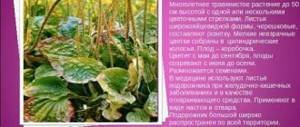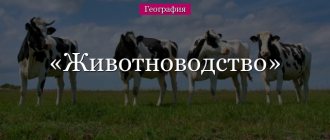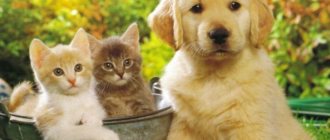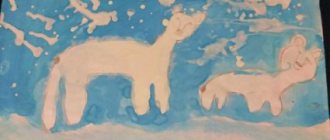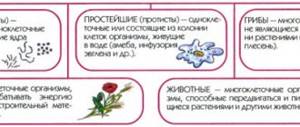The main goal of all the actions of a small child is to study the world around him, its laws, the dependence between one and other objects. This process cannot be imagined without studying the animal world. From early childhood, the baby is surrounded by all kinds of animal toys, their images in books that the mother reads, and many also have furry or feathered pets living in the house. Pets for preschool children are a very exciting topic. How can I help them study it?
Funny pictures
Pictures are the most accessible visual material when studying almost any topic with preschoolers. For the youngest children (about a year old or even a little less), toys are more suitable (you can purchase special plastic sets from the home series). But bright, large pictures may also be of interest to them, especially if they are colorful and without unnecessary variegation. Well, if you have the opportunity to see someone in person, even better. Up to a year old, children usually get to know animals this way.
For children 2–3 years old, it is already useful to be able to compare “cartoon” images - in cartoons, children's books (or toy figures) - with realistic pictures or photographs. It is better to make such cards from thick cardboard with rounded corners and laminate them. This will make them durable and allow them to be used in all kinds of games with children of older preschool age. For example, you can write a letter or a whole word next to each picture to teach reading.
Also useful for reinforcing games are pictures depicting individual parts of the body of different animals and cut cards consisting of several parts (depending on the age of the child). Pictures can be purchased in ready-made sets or downloaded from the Internet and printed.
Who's first on the list?
Everything here is individual. Most often, the first item on the list is a plush kitten or puppy. But this is not an axiom. Perhaps there is some kind of pet or pets living in the house (not necessarily a cat or dog - it could be a parrot, guinea pig, hamster, rat). Then, most likely, they will become the first subjects in the study of the animal world.
In addition, the sequence of study is influenced by the place where the preschool child lives: village children have a better chance of meeting a cow, a pig, and other inhabitants of the homestead. City dwellers prefer cats and dogs.
Rat for a child
These are calm, balanced, sociable, intelligent pets. They love all family members and always try to climb onto your lap or shoulder when the opportunity arises. But do not forget that these pets are fragile.
They need constant communication, they love to run around the apartment, and also hide tasty things in secret places.
The colors of the animals can be different - peach, white, black, spotted, or completely hairless (sphinxes). It is better to keep rats in cages. These are rodents, they constantly need to chew, so sometimes the wires in the house and some things get damaged. It is necessary to hang special hard tasty sticks in the cage (can be purchased at a pet store)
The main part of the daily diet consists of grain feed, vegetables, fruits, and herbs. Protein food, vitamin and mineral supplements are not given every day and not in large quantities. Fresh water is a must.
A child can easily feed a rat and make sure there is water in the sippy cup, but cleaning the cage is best done by an adult.
The life span of rats is not long, only 2-3 years. The cost of a baby rat in a pet store is from 150 rubles. The most expensive is the cage and its equipment.
Which pets can you tell your kids about?
It is better for younger preschoolers to start getting acquainted with the most common ones. For example, camel, rabbit, nutria, quail or turkey can be “save” for a while. And start with those representatives of the domestic fauna that are heard and visible (in books with fairy tales, poems, songs, in cartoons or television shows):
- cat;
- dog;
- cow;
- horse;
- ram;
- goat;
- pig.
You can also include poultry here: chickens, ducks, geese. Only the child needs to explain the difference between a bird and an animal if he himself does not yet understand it.
Training must be carried out in the child’s “coordinate system”: he knows that all creatures are different in appearance, have different names, they have fathers, mothers and babies, they “talk” in their own way and eat different foods. Therefore, each story must begin with a general description: what the animal is called, what it looks like, what sounds it makes, what the fathers, mothers and cubs of different animals are called, what they eat. At the end of such a story, you need to add information about how each of them is useful for a person.
Wild or domestic?
If parents are actively involved with a child, then by the age of two or three he already has a full understanding that some animals live with people, and some live in the forest or steppe. Therefore, it is quite possible to explain to him the differences between pets and wild animals:
- live next to a person;
- are not afraid of humans, many of them are completely tame;
- know their master;
- receive food from him;
- take care of their offspring together with them;
- live in a house made by the owner;
- their cubs are safe - they will not be attacked, for example, by wolves or bears, as in the forest;
- serve a person or bring him other benefits.
If your little know-nothing starts asking about someone who isn't on your list, don't stop him. Answer his questions, show him a picture of the animal, look for information about it. Don’t extinguish the brightest and most useful spark in your mind – curiosity. It will help him be more successful in school in the future.
Why shouldn't you have animals?
Despite all the benefits of owning a pet as a companion for children, not all families should have a pet. When purchasing animals, we take full responsibility for their life, health and comfort, and providing the necessary conditions is not always easy. Often, buying an animal is an impulsive decision that the whole family may later regret. Why shouldn't you have animals?
Contraindications for health
Allergies, susceptibility to various diseases and other health problems in any family member can be a serious obstacle. Sometimes allergic reactions can be stopped, but in some situations, contact between a child and an animal can become dangerous. Before purchasing an animal, the whole family should make sure there are no health contraindications.
Strong reluctance of one of the family members
Let's imagine that the head of the family really doesn't like dogs, and you buy a pug because you think that over time they will get along. A month or two passes, and the husband still gets irritated as soon as he sees the dog. Was it worth the risk of purchasing a pet in the hope that the rest of the family would get along with it later? Isn't it better to choose a pet that suits the character and preferences of the whole family?
Unstable period of life
A rented apartment, a planned job change, or a move is not the best time to bring a pet into your home. If you don’t have the energy, time and money even for current tasks, you shouldn’t take an animal in the hope that it will relieve stress. In such a situation, stress can only increase.
Lack of time, experience or desire of parents to teach the child the basics of safe and humane treatment of animals
Although the child will learn many aspects of communicating with an animal on his own, the first times they interact should be under parental supervision. Children cannot always calculate force, understand a pet’s language, or assess the safety of their actions.
A psychologist tells how to teach a child to communicate with animals:
There are many reasons why you should not have animals at home: medical contraindications, lack of consensus among all family members, unstable period of life, lack of time. However, in addition to purchasing animals, there are many other ways to interact with them to benefit your child.
To remember better
As you know, children learn much more easily information that is presented in a fun way, like a fairy tale or a game. When we study pets with our children, we teach them to take care of pets, treat them with care, and not harm them. That is, we make our children not only smarter, but also kinder and more responsible. To ensure that all this knowledge does not remain dead weight, it is important to make consolidation of the studied topic fun and interesting. The following can help with this:
- cartoons;
- fairy tales or stories about animals;
- poems, songs;
- puzzles;
- proverbs, tongue twisters;
- drawing or sculpting.
Who are pets
Pets are animals that have been tamed by humans by caring for them and providing them with food. All domesticated species and artificially bred breeds based on them were used for the purpose of obtaining material gain or pleasure. They became good companions for a person, brightening up his life. The process of animal reproduction occurs easily even outside natural conditions. By controlling it, people create breeds with the desired properties.
Interesting! Alternative medicine has long noted the ability of animals to heal people. Cats achieve the greatest success in this. Scientists explain the effectiveness of cat therapy by the ability of this animal to create a unique electromagnetic field with low-frequency currents thanks to its thin and soft fur. This allows the cat to act on the source of inflammation and pain and destroy microbes.
Scientists have proven that stroking an animal is not only pleasant, but also useful. During the bioenergetic contact that occurs in this case, the central nervous system of people receives special impulses that cause positive emotions and improve mood. Therefore, communication with cats is especially important during psychological disorders and stress.
Shall we play?
And, of course, an indispensable tool for this purpose is the game. There are many games you can come up with. Here are some examples:
- Who “says” what? The parents name the animal, and the child must say what sounds it makes, and then demonstrate it: the cat meows (meow); the pig grunts (oink).
- Who eats what? The child is offered two stacks of cards. In one there is an image of animals, in the other - their food. He must choose the correct options (hay - cow, bone - dog, grass - ram).
- Dad, mom, me. You can offer your child images of females, males and cubs, and let him sort them into “families” and name them (cat-cat-kitten, horse-horse-foal, ram-sheep-lamb, cow-bull-calf). Or you can show one person, and let the child name the rest of the “family members.”
- Where I live? The mother shows her son or daughter a picture of an animal, and the child must say the name of his house (a cow has a barn, a horse has a stable, a dog has a kennel). For children under 3 years old, it is better to offer two stacks of cards and ask them to choose the right pairs.
- What's the benefit? An adult shows an image, and a preschooler must name how this animal is useful (a dog is a guard, a cat is a mouse catcher, a cow is a milk giver, a ram, a goat is wool).
- Paws, whiskers and tails. The little player's task is to guess who owns the body part shown on the card. These can be muzzles, paws, horns, udders, snouts, etc. Another option for the game is to place cards on both sides of the child: on one side - with body parts, on the other - the remaining images without these parts. Let him try to find the owners of all paws, whiskers or tails.
- Animal puzzles. Pictures with a whole image are cut into several parts (the older the child, the more parts there are) and he is asked to assemble them. And then let him tell you what he remembers about the collected animal.
- Say it kindly. Mom says: “dog”, the child must answer: “dog”; “sheep” - “lamb”, “horse” - “horse”, etc.
- It's become a lot. The principle is similar: translate what is said into the plural form (a pig slurps - pigs slurp, a cat laps - cats lap).
- Who's the odd one out? The player’s task is to choose an extra image from the cards offered and name the feature (for example, among 4 pictures with domestic animals, put one with a wild one; or with animals - a bird, with horned ones - a hornless one, with adults - a baby...).
Learning about pets with children is always easy and fun. The baby will not have to be specifically seated to study - he will quickly become involved in the process and will probably begin to ask many clarifying questions. This is a natural process. He says that the baby is developing correctly. The task of adults is to definitely help him with this.
Lesson summary on the topic: “Pets. Lesson-travel.
Organizational moment.Psychological attitude
- Look how good the weather is. The sun greets us and gives us its rays of goodness, happiness, and health. The sun “smiles.” Let us smile and give each other a great mood.
I wish you good relations with each other, be attentive and patient during the lesson.
3. Report the topic of the lesson
Today in the lesson we will get acquainted with domestic animals and professions of people.
-Do you love to travel?
“Then I suggest you go on a trip to a village farmstead, to an unusual school.”
A farmstead is a farmstead attached to a rural house.
And why to go to an unusual school you will tell yourself at the end of our lesson.
Sl.1.
Before we go on a journey, we must prepare our speech for work.
Speech warm-up
1. Inhale-exhale.
2. The gray cat walks (tongue left, right) Yawns sweetly, sweetly (mouth wide open) She laps milk (stick out tongue, then remove) The cat licked her lips (lick her lips) The cat showed her teeth (smile) And “SPA-SI- BO "told us" (say "Thank you")
3. To be honest:
Ko-ko-ko-cat loves milk.
- Well done boys! And now we can safely go to an unusual school, where everything is different from ours.
And we will go to the village of Vseznaykino on this beautiful bus. Make yourself more comfortable. -Who drives the bus?
-I have a magic chest, each of you will take out a card with a picture of a geometric figure from it. The one with the triangle shown will be the driver of our bus.
-What should a driver be like? (attentive...
The driver is ready! Let's go! (Fragment of the song “We are going, we are going..) So we have arrived. We are with you in a village courtyard .
-There are so many possible animals and birds here. Now we will learn more about those who live in a village yard, next to a person.
Sl.2.
- To begin with, I will introduce you to the teacher of this school. Listen to the riddle.
He is in a bright uniform, Spurs for beauty. During the day he is a bully, In the morning he is a clock. (Rooster )
Sl.3
slide appears on the screen )
- Now let's meet his students:
Sl.4.
Pied Quack Catches frogs. He waddles and stumbles. (Duck)
Red Dairy Chews by day and chews by night, After all, grass is not so easy to process into milk. (Cow)
He is friends with the owner, guards the house, lives under the porch, has a tail like a ring. (Dog)
He wanders importantly through the meadow, comes out of the water dry, wears red shoes, gives soft featherbeds. (Goose).
I know how to wash myself cleanly, not with water, but with my tongue. Meow! How often I dream about a saucer with warm milk! (Cat)
I clatter my hooves, I clatter, I gallop, I gallop. A thick mane develops playfully in the wind. (Horse)
He makes his way to the trough, Scrubs everyone sideways, Unwashed buyer With an unchangeable heel. (Pig)
A ball of fluff, a long ear, jumps deftly, loves carrots. (Rabbit)
(When you name the answer, an animal slide with animals
-Well done boys.
Name the students of this unusual school?
-Which 2 groups can they be divided into? Why did these birds end up in this school? Do you think they are redundant or not? Why?
- Why do we call these animals pets? (conversation). What other animals are there?
-Where do they live? What do these animals eat?
Domestic animals live near human habitation, in specially built premises (barn, stable, stable, pigsty, kennel).
People look after them and feed them, prepare food for them. They bring benefits to humans: milk, meat, wool, etc.
The cow is considered the breadwinner in the family, as it provides meat and milk. What products are made from milk? (cheese, cottage cheese, sour cream, kefir, feta cheese).
Sheep and goats provide meat, wool, from which very warm clothes are knitted, and skins for fur coats and sheepskin coats. Goat milk is a healthy and healing drink. It is well suited for baby food and improves the well-being of older people and those suffering from gastrointestinal diseases.
Chickens provide humans with meat, eggs, and feathers. Rabbits provide fluff from which warm sweaters, socks, and blankets are knitted. The pig provides meat and lard.
Horse - meat, milk and
How much food does a person get from domestic animals? Pets are truly our helpers. We get all the most valuable products the body needs from them. What professions do people take care of animals? (Grooms, milkmaids, shepherds, poultry workers)
We will continue to take care of them, because people are responsible for those they have tamed.
Well done boys!
- Let's look into the classroom at the Pet School and listen to what is being discussed in class. Maybe we, too, will be able to complete the tasks that the rooster offers his students? In winter and spring, domestic animals give birth to babies. The Rooster suggests playing the game “Who was who in childhood?”
(The cockerel appears on the screen again and words come out, the teacher reads out the assignments slide 4 )
—Now listen to the poem
. There are missing words in it. Whoever guesses, I ask you to raise your hand, who was who in childhood:
Once upon a time there was a little puppy, He grew up, however, And now he is not a puppy - But an adult...
The foal grew up every day and became...
This important cat Fluff was small... And the brave cockerel was Tiny...
— Continue listing who was who in childhood:
Level 5
